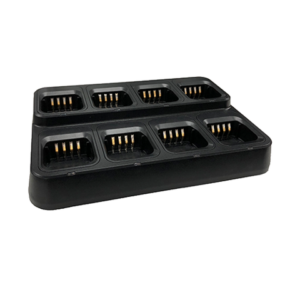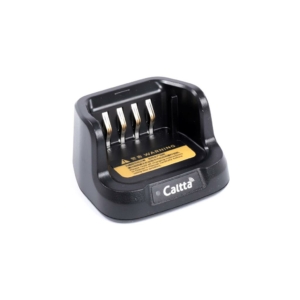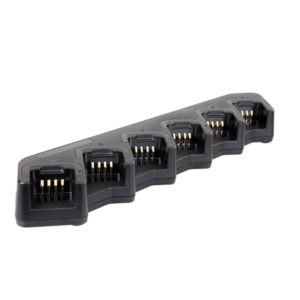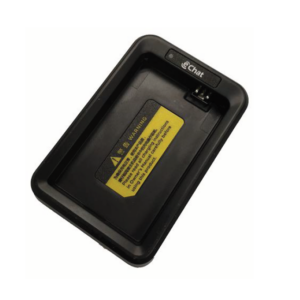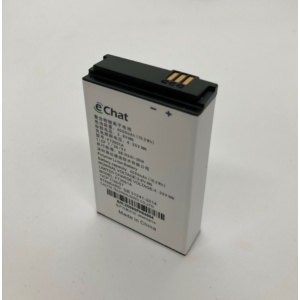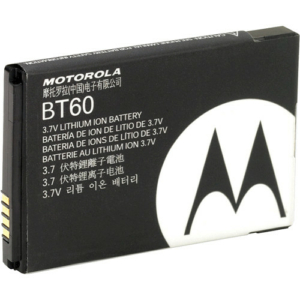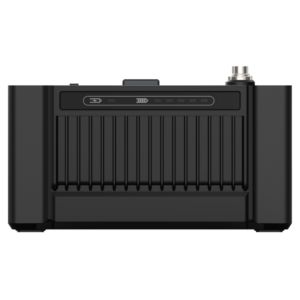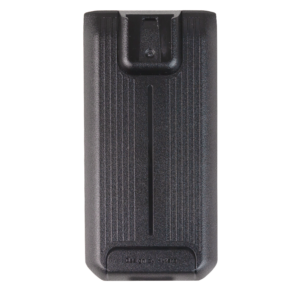Transceivers often use rechargeable batteries to make the radios portable and the batteries easy to replace. In this post, we have compiled some important information and tips on transceiver batteries and how to charge them.
Currently there are 3 types of batteries commonly used in standard transceivers: Ni-MH, Li-ion and Li-polymer. Transceiver batteries usually have a capacity of between 1000 and 3000 mAh, however, the different types of batteries can differ in size and weight.

Ni-MH batteries
The abbreviation "Ni-MH" stands for a special type of rechargeable battery: the "Nickel-Metal Hydride" battery. These batteries are more environmentally friendly and offer better performance than nickel-cadmium (NiCd) batteries that were ubiquitous a few years ago and which are considered to be an older generation of batteries.
Ni-MH batteries are widely used in a variety of devices such as remote controls, cameras and toys. Their main advantage is that they are less prone to the phenomenon called the "memory effect", which can lead to a reduction in battery performance if the battery is not fully discharged and then recharged. This makes Ni-MH batteries an efficient and environmentally friendly power source for a wide range of everyday devices.
However, their energy density is lower, which means they store less energy in the same mass of battery.

Li-ion batteries
Lithium-ion (Li-ion) batteries are the most widely used rechargeable batteries. They have a higher energy density than Ni-MH batteries. These modern rechargeable batteries use lithium ions in the chemical reactions.
They are used in many electronic devices such as smartphones, laptops and electric vehicles. Outstanding advantages of lithium-ion batteries include high energy storage, low self-discharge, no "memory effect", fast charging capability. However, it is important to know that these batteries also carry risks, such as sensitivity to excessive heat and overcharging, and it is advisable to follow the manufacturers' recommended specifications and precautions for safe use.

Li-polymer batteries
The abbreviations "Li-polymer" or “Li-Po” refer to "Lithium-polymer" batteries. These are rechargeable batteries in which the lithium ions are dispersed in a polymer gel or solid polymer, unlike conventional liquid electrolyte lithium-ion batteries. This type of batteries offer several advantages.
Lithium-polymer (Li-Po) batteries are similar to Li-ion batteries, but they are flatter and lighter than Li-ion batteries. Their efficiency comes at a price, as they are more expensive than Li-ion batteries. Their more flexible design allows them to be used in devices of special shapes and small sizes.
They can also be lighter and thinner, providing higher energy storage and better temperature tolerance. As a result, they are widely used in a wide range of portable electronic devices, from smartphones to drones. Their energy density is higher than Ni-MH batteries.

Which batteries are used in different types of transceivers?
Ni-MH batteries can usually be found in hobby transceivers, mainly PMR446 walkie talkies. These devices work with a slower charging rate, but in exchange you can easily change the battery cells, even to alkaline batteries. Li-ion batteries have also been introduced in newer models, reducing the size and weight of the radio.
Business and industrial two-way radios as well as higher powered amateur radio transceivers are more likely to come with Li-ion and Li-Po batteries. Here, high power handling and long operating times are important. These batteries can usually be charged using a docking charger.
Also available for some devices are "smart" batteries (such as Motorola Impress), which can monitor the different properties of the battery, allowing a much longer battery life, but they require a special charger.
Chargers
There are two different types of chargers: commercial (mass-produced) chargers and industrial chargers.
Commercial chargers are offered in attractive packaging to go with products such as mobile phones, laptops and video cameras. These chargers are relatively inexpensive and work well when used with the devices they are shipped with. The commercial charger is therefore recommended for simple use only.
On the other hand, industrial chargers are designed for continuous use and can often charge a group of batteries simultaneously. You can choose between single and multi-slot configurations. Industrial chargers often include special features such as negative pulse charging, discharge function to condition the batteries, state of charge (SoC) and battery status (SoH) indicators.
Lack of protection against overcharging is the most common problem, especially when using nickel-based batteries. Charging and standby at high temperatures will destroy batteries. A sign of overcharging is if the battery remains hot even after charging is complete. However, a certain temperature rise cannot be avoided when charging nickel-based batteries.

The temperature reaches its highest value when the battery is fully charged and should then decrease while the battery charging light is on and the charger switches to trickle charge mode. The battery will eventually cool down to room temperature. If the temperature does not drop but remains above room temperature, the charger is not working properly. If the charging light is on, remove the batteries from the charger as soon as possible. Any further drip charging may damage the batteries.
This warning is particularly true for Ni-MH batteries, because this type of cell is not very tolerant of overcharging. In fact, a Ni-MH cell will remain cold when touched even under high current drop charging, while suffering damage from overcharging. This also causes a shortening of battery life. A lithium-ion cell should never be hot in the charger. If it is, the cell is either faulty or your charger is not working properly. Such batteries or chargers should no longer be used. It is best to store batteries on the shelf and fully charge them before use rather than keeping them in the charger for days.
Even with a seemingly correct drop charge, there is a certain degree of crystallisation, which later results in a memory effect if you forget your battery pack in the charger. Also, due to the significant self-discharge of nickel-based cells, it is advisable to fully charge before use. Li-ion chargers allow you to leave your battery in for longer periods of time, as the electronics built into the battery ensure that the charging current is properly regulated.
Slow charger
Also known as a normal charger or overnight charger, the slow charger works with a fixed charging current of one tenth (0.1C) of the battery capacity. Charging is continuous as long as the batteries are connected to the charger.
The charging time is 14-16 hours. In most cases, there is no overcharge detection, which would switch the charger to low-current drip-feed mode at the end of the charge. The advantage of the slow charger is its low cost, but it can only be used with Ni-Cd batteries. If you want to use both Ni-Mh and Ni-Cd batteries, you will need to replace your device with a more advanced unit. The battery will be lukewarm in the charger after reaching full charge. In this case it is not necessary to remove the battery immediately, but do not keep it in the charger for more than a day. The best solution is to remove the cells after they are fully charged, i.e. after 14 hours or when they are hand-hot.
The problem arises when charging a smaller capacity battery (low mAh) with a charger designed for larger cells. Although the charger will behave correctly in the initial charging phase, the battery will start to heat up at 70% charge. Since it is not possible to charge with low charging currents or to interrupt the charge, overheating due to overcharging in the second phase of charging will cause cell failure. If a suitable charger is not available, the user must monitor the temperature of the battery being charged continuously and disconnect the battery when it has warmed up.
The opposite can also happen when charging a larger battery with a charger designed for smaller cells. In this case, you will never achieve a full charge. The battery remains cold during charging and performs below the expected performance. In nickel-based batteries, therefore, the continuous undercharging leads to the memory effect, which results in a significant reduction in capacity.
Quick charger
The so-called "quick charger” or “rapid-charger" is one of the most popular charger variants. This device is positioned between the slow and the fast charger, both in terms of charging time and price.
Charging is completed in 3-6 hours with a charging current of around 0.3C. Charge control electronics are built in to switch off the charge when the battery is fully charged. A well-designed fast charger will give much better results than a slow charger. Our batteries will have a long life if we charge them at a higher current, protect them from overheating and don't overcharge them. Fast chargers can be used for both nickel and lithium based cells. These two types of cells should not normally be charged in the same charger.
Fast charger
The fast charger has many advantages over other types. Its main advantage is shorter charging times, although it requires a larger power supply and more expensive and complex control circuitry. The price of a fast charger is higher, but the investment pays off in the reliability and long life of the batteries.
The charging time depends on the magnitude of the charging current, which is determined by the capacitance of the cell and the chemical properties of the electrolyte. At 1C charging current (which is the same value as the cell capacity), the charging time of a depleted Ni-Cd cell is not much more than 1 hour. When the battery is fully charged, some chargers switch to a so-called "topping" charging mode, starting a timer until the charging cycle is completed at a reduced charging current. When this occurs, the charger switches to drip-feed mode. This "maintenance" charging compensates for the self-discharge of the cells.
Advanced fast chargers are suitable for both Ni-Cd and Ni-Mh batteries. Since fast chargers work with relatively high currents and you need to keep an eye on the cells while charging, it is very important that you only charge the type of batteries specified by the manufacturer! Some battery manufacturers electronically code the batteries to identify their chemical characteristics and charge rate. The charger can then accurately set the charging current and the optimal charging algorithm.
Gel-acid and Li-ion batteries require different algorithms and are not compatible with the methods used for nickel-based cells. Fast charging is best for nickel-based batteries. Slow charging can lead to a high-crystalline state in nickel-based cells, resulting in poor battery performance and reduced battery life. The temperature of the cells remains moderate during charging and the temperature peak is shorter than necessary. It is not advisable to keep the battery in the charger for days, even when using a correct trickle charge current. It may still be necessary to keep the battery in the charger for continuous standby, in which case it is advisable to carry out a conditioning (charge-discharge-charge) cycle every month.
Charging Ni-MH batteries
Ni-MH battery chargers are very similar to Ni-Cd system chargers, but usually have more complex electronics. Ni-MH cells have a very small voltage drop near the charged state, so the NDV method cannot be used at charging currents below 0.5C and at higher temperatures. Old or not fully uniform cells make detection even more difficult.
The variation in the state of the different cells within the battery pack becomes even more intense as the cells age and the number of cycles progresses, which makes the NDV (Negative Delta V) method difficult to use. A Ni-MH charger operating on the NDV principle should respond to voltage changes of 16mV/cell or less. However, over-sensitivity of the charger can easily cause it to stop fast charging for any small voltage change, even half way through the cycle.
Voltage fluctuations and electrical noise induced by the battery and charger can easily fool a circuit that is set too sensitive. The popularity of Ni-MH batteries has led to a number of newly developed charging methods. Many devices in use today employ a combination of the NDV principle, voltage constant, temperature variation over time (dT/dt), temperature threshold, and charge timer circuits. This type of charger will stop fast charging when any of the aforementioned circuits is tipped.
Cells that are charged using the NDV or temperature-peak-sensing principle achieve a higher capacity value than those charged using a less aggressive method. The gain for a good cell is about 6%. This increase in capacity is due to a slight overcharge during the cycle, but has the negative effect of shorter cell lifetime. Instead of the 350-400 charge cycles expected, the battery can fail after as few as 300 cycles.
Similar to Ni-Cd charging processes, many Ni-MH fast chargers operate on the basis of the rate of temperature rise (dT/dt). A temperature change of 1°C/min always results in the completion of the charge. The absolute cut-off temperature is 60°C. A topping charge of 0.1C for 30 minutes makes the charge cycle efficient, followed by a continuous drip charge to keep the battery fully charged. A charging current of 1C is most appropriate during the initial charging phase. After a voltage peak is reached, a cooling period of a few minutes follows, after which charging continues at a lower current.
When the next charge threshold is reached, the current is again reduced by one notch. This process is repeated until the battery is fully charged. This "step-differential charge" method works for both Ni-Cd and Ni-MH cells. The amount of charge current is determined by the nominal capacity of the cell, which is also the initial charge current, and then the current is gradually reduced until the charge is complete. This avoids the thermal runaway that can occur at the end of the charge cycle due to the cells' reduced charge retention capacity.
For Ni-MH cells, fast charging is preferable to slow charging. The amount of drop charge applied is essential to maintain the charged state. Since Ni-MH cells are not very tolerant of overcharging, the drop charge current should be lower than that used for NiCd batteries! The recommended trickle charge current for Ni-MH cells is about 0.05C. This is why an NiCd charger cannot be used to charge Ni-MH cells unless it supports both types, however a lower trickle charge current can be used for NiCD cells.
It is very difficult, if not impossible, to slow charge Ni-MH batteries. Between 0.1C and 0.3C charge current, the voltage and temperature profiles do not show evaluable characteristics to measure the full state of charge, so fast charging must depend on a timer. Overcharge damage can be caused by placing a partially or fully charged battery in a charger with a fixed timer. The same is the case if the cell has a reduced charge holding capacity or is old and can only hold 50% of the charge. The fixed timer will therefore always apply the assumed 100% charge rate, regardless of the battery condition, causing an overcharge.
Overcharging can occur with Ni-MH batteries even if the battery is kept cool. Some cheaper fast chargers are not capable of fully charging batteries. These so-called economy chargers base their full charge detection directly on the occurrence of a voltage peak or the crossing of a temperature threshold.
Charging Li-ion batteries
Li-ion chargers are similar to gel battery chargers that operate on the principle of voltage limitation. The difference is in the higher cell voltage, the tighter voltage tolerance and the elimination of drop and float charging after full charge. While gel batteries allow some flexibility in terms of voltage drop under load, Li-ion cell manufacturers are very strict about the exact voltage.
When the Li-ion battery was first produced, the graphite system specified a voltage of 4.1 V/cell. Higher voltages provide higher energy density, but cell oxidation severely limited the lifetime of the initial Li-ion cells charged above 4.1 V/cell. This effect was counteracted by chemical additives. Most commercially available Li-ion cells have a voltage of 4.2 V, and the tolerance is strictly 0.05 V in all cases.
Industrial and military Li-ion batteries are designed for maximum cycle life and have a charging end voltage of approximately 3.9 V/cell. These batteries are lower on the Watt-hour/kilogram scale, but promise long life due to their high energy density and small size.
The charging time for all Li-ion batteries is around 3 hours, charged with an initial charge current of 1C. The cell remains cold during charging. Full charge is indicated when the voltage remains at the upper, holding limit while the charging current drops below 3% of the initial value. For Li-ion chargers, Increasing the charging current does not shorten the charging time significantly. Although the voltage peak is reached sooner, the subsequent final charge will be longer.
If you still have questions about batteries and charging after reading this blog article, please feel free to contact our technical team on the Contact page and they will be happy to answer any questions you may have.

